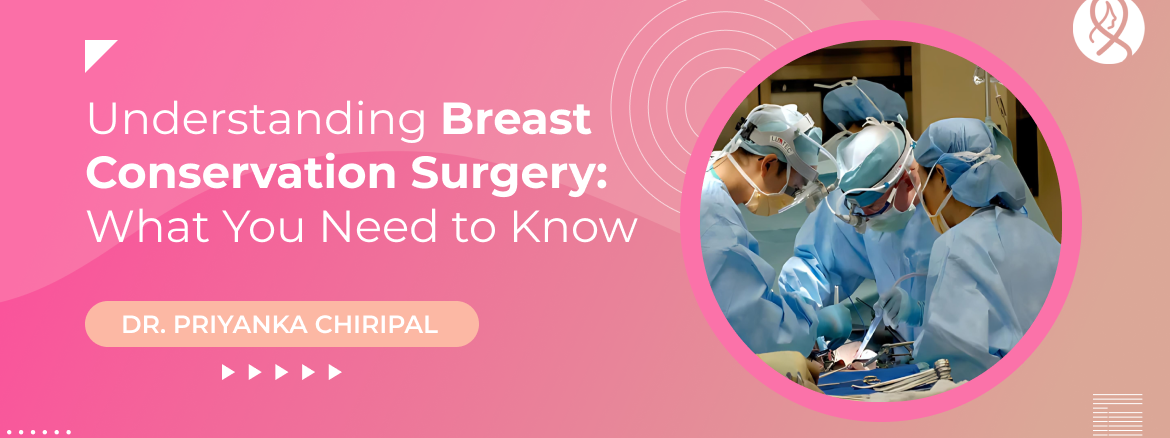Breast Conversation Surgery is a breast cancer treatment. In this treatment the aim is to remove cancer from the breast. The breast cancer surgeon removes the area of cancer and the surrounding breast tissue. They leave as much breast as possible.
Breast conserving surgery is also known by several other names such as lumpectomy, quadrantectomy, partial mastectomy, or segmental mastectomy depending on how much tissue is removed.
In this blog, we are going to dive into some important details of Breast Conservation Surgery, so let’s start without waiting much.
Who is most appropriate for breast conservation surgery?
BCS may be used in conjunction with other breast cancer treatments. Among other things, the kind and stage of your breast cancer will determine if you qualify for BCS. During your consultation, the surgeon will go through these with you.
Research indicates that long-term survival chances for women undergoing radiation therapy after breast cancer surgery (BCS) are comparable to those of women undergoing a mastectomy, in which the entire breast is removed. Your surgeon might recommend BCS for various reasons. But BCS is not possible for all women. Your surgeon will go over all the options for surgical therapy in detail with you to address your concerns.
When you go for this treatment, just make sure that you choose the best breast cancer surgeon.
What is the Procedure of Breast Conservation Surgery?
Breast Conservation Surgery (BCS) can be done on an outpatient basis. It means that the patient can go home on the same day. The procedure may depend on your condition and healthcare provider’s practices.
Here is the general process of BCS:
- The patient will be asked to remove clothing and given a gown.
- An IV line could be started in your arm or hand.
- Resting on your back, you will lie on the operation table.
- BCS may be done under anesthesia with IV sedation. This means that the area being worked on will be numbed. To assist you relax, you will be given sedative medication through your IV before the treatment. Throughout the surgery, you will most likely be awake but tired.
- BCS procedures can also be carried out while sedated. During the procedure, you will be given medication to put you into a deep slumber.
- Now, the heart rate, blood pressure, and oxygen level will be checked of the patient.
- A sterilized solution will be used to clean the skin above the surgery site.
- There will be a little cut (incision) made over or close to the breast tumor. The lump or irregularity will be removed by the medical professional. Additionally, a portion of the surrounding normal breast tissue will be removed.
- An extra surgical incision in or close to the armpit may be needed if the lymph nodes beneath your armpit must be removed.
- A pathologist will examine the removed breast tissue and any other tissues in the lab.
- It is possible to put a drainage tube into the damaged area.
- Stitches or adhesive strips will be used to close the skin.
- The area will be covered with a sterile bandage or dressing.
Benefits of Breast Conservation Surgery
Here are the benefits of Breast Conservation Surgery:
- Preserves body image & self-esteem
For many people, breasts are not just a physical aspect but are an important part of their identity and femininity. Breast conservation surgery may help maintain one’s sense of self-worth and body image. Research has indicated that women who choose to have a breast conservation surgery report feeling better about their bodies and more confident than those who choose to have a mastectomy. - Maintains sensation and functionality
One of the major benefits of breast conservation surgery is that it preserves natural breast tissue as much as possible.
The breast conservation surgery will help in maintaining the sensation and functionality in the breast. - Fast recovery time and other complications
Generally, breast conserving surgery has fewer post-operative problems and a shorter recovery period. On the other hand, a mastectomy is a more involved surgical operation that may result in more pain, lengthier hospital stays, and a longer recovery period. - Better for emotional and psychological well-being
The emotional and psychological health of individuals who have survived breast cancer is critically important. A breast loss’s emotional toll can be lessened with breast conservation surgery. Its ability to maintain sensations and physical appearance can help patients emotionally adjust to life following treatment in a more positive way.
Conclusion
Overall, breast conservation surgery presents a suitable alternative for most patients with breast cancer, with the potential to maintain the majority of the breast’s cosmetic and physiological integrity without significantly compromising survival outcomes



